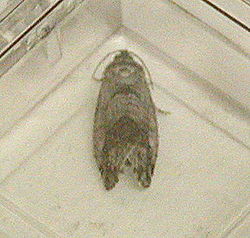- Cydia deshaisiana
-
Cydia deshaisiana 
adult C. deshaisiana Scientific classification Kingdom: Animalia Phylum: Arthropoda Class: Insecta Order: Lepidoptera Family: Tortricidae Tribe: Grapholitini Genus: Cydia Species: C. deshaisiana Binomial name Cydia deshaisiana
(Lucas, 1858)Synonyms Carpocapsa deshaisiana
Carpocapsa saltitans
Cydia saltitans
Laspeyresia saltitansCydia deshaisiana or jumping bean moth is a moth from Mexico that is most widely known as its larva, where it inhabits the carpels of seeds from several species of the shrub genus Sebastiania (S. pavoniana or S. palmeri). These seeds are commonly known as Mexican jumping beans.
The moth lays the egg on the young pod. The hatched larva gnaws into the seed, which closes the minute hole during its growth. The larva attaches itself to the bean with many silken threads by hooks on its anal and four hind abdominal prolegs. When the bean is abruptly warmed, for instance by being held in the palm of the hand, the larva twitches and spasms, pulling on the threads and causing the characteristic hop. "Jump" is often an exaggeration, but the beans nonetheless do move around quite a bit.
The larva may live for months inside the bean with varying periods of dormancy. It eats away the inside of the bean, making a hollow for itself. If the seed is cut, the larva will repair the hole with silk.
If the larva has adequate conditions such as moisture, it will live long enough to go into a pupal stage. In preparation to this, it eats a circular hole through the shell in February and closes it again with a silken plug. This is to enable the jawless adult moth to escape from the seed. After completion of the exit hole it spins a cocoon within the seed, with a passage way leading to the door. During the following pupal stage the larva will not move any more. Normally in the spring, the moth will force its way out of the bean through a round "trap door", leaving behind the pupal casing.
The small, jawless silver and gray-colored moth will live for only a few days.
Contents
Synonyms
Commonly used synonyms for the species are Carpocapsa saltitans or Laspeyresia saltitans — carpo indicating that it lives within a seed (see podocarp), and saltitans referring to its jumping behavior.
References
- (1876). Jumping Seeds and Galls. American Naturalist, Vol. 10(4):216-218.
See also
- Emporia melanobasis, a moth with similar habits, parasitizing in Spirostachys africana.
- Nanodes tamarisci, acting similarly in the seed of Tamarix.
- the gall wasp Neuroterus saltatorius shows similar behavior in galls produced in several oak species, although during the pupal state.[1]
External links
Categories:- Grapholitini
Wikimedia Foundation. 2010.


